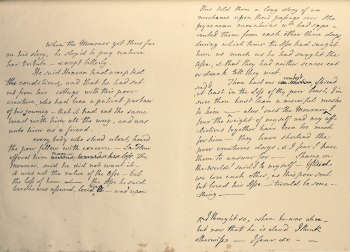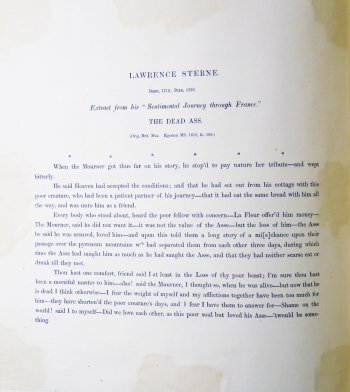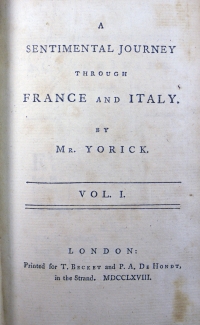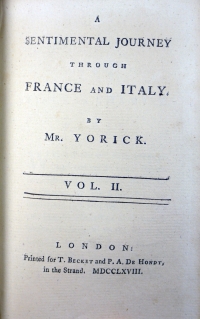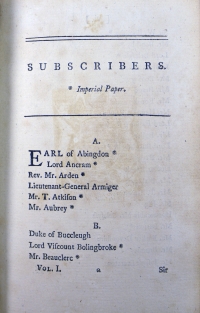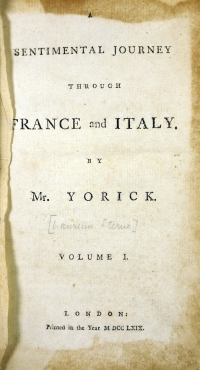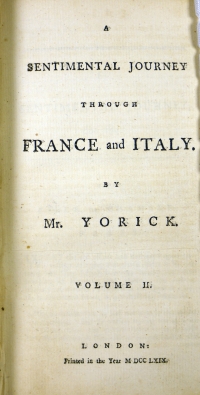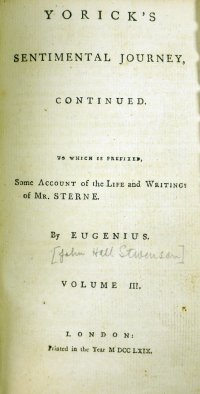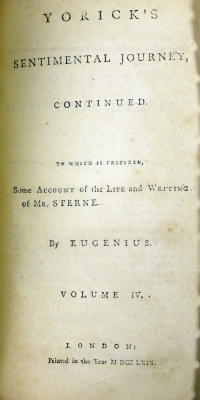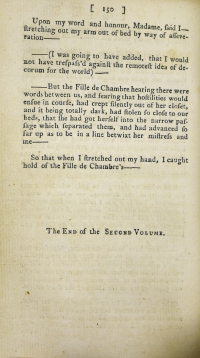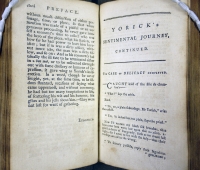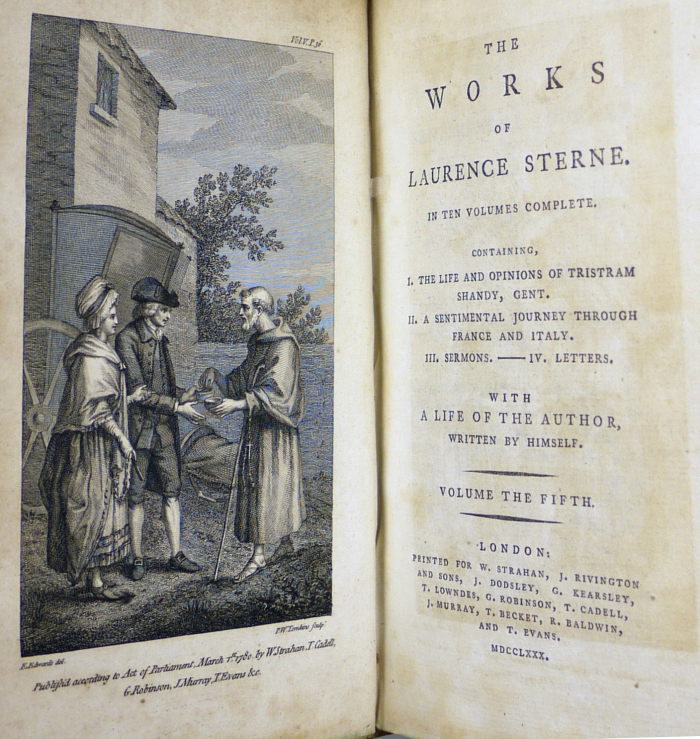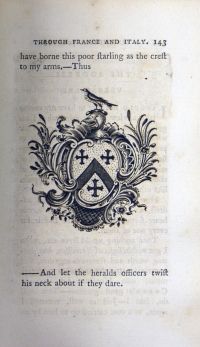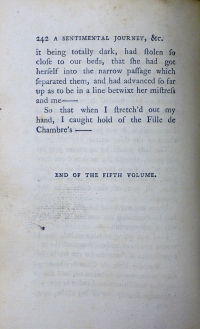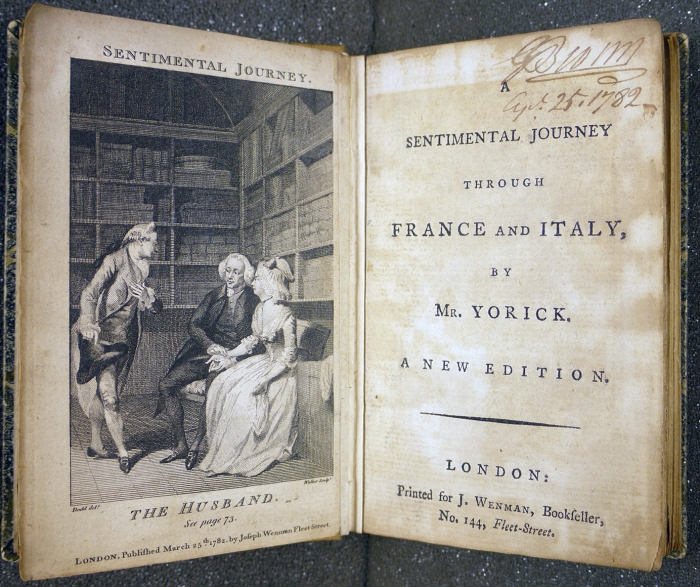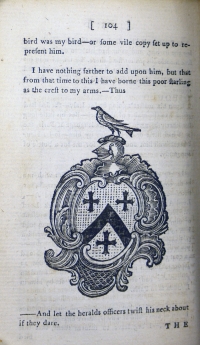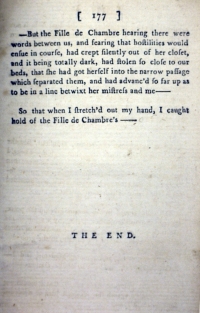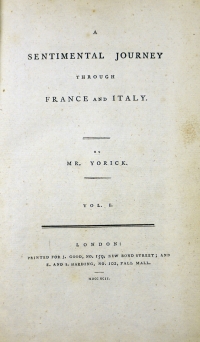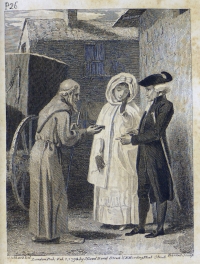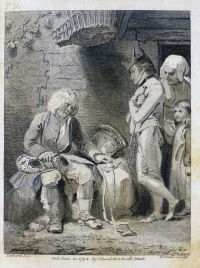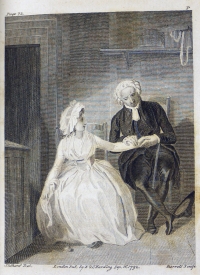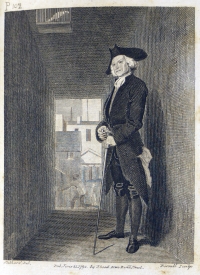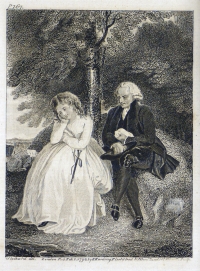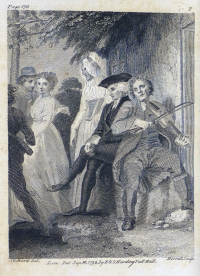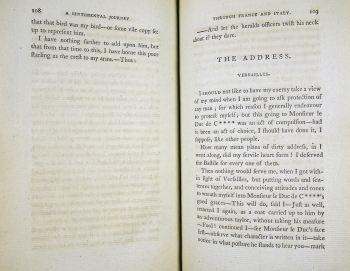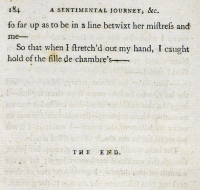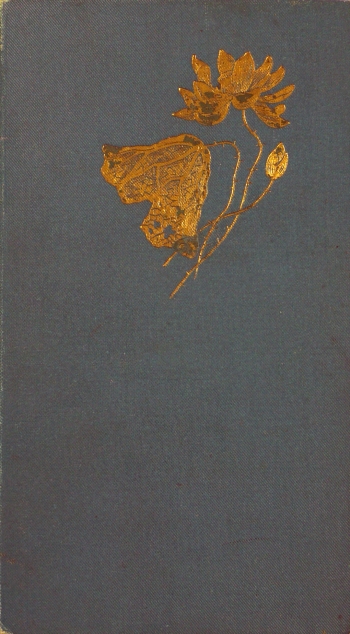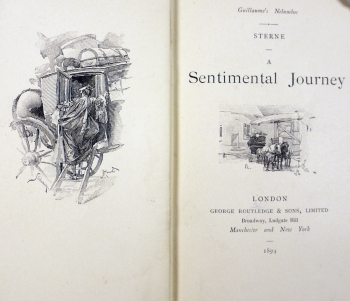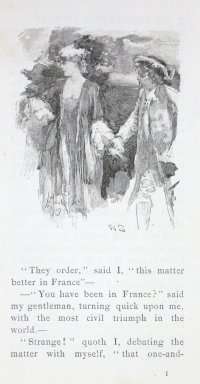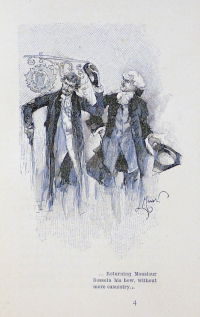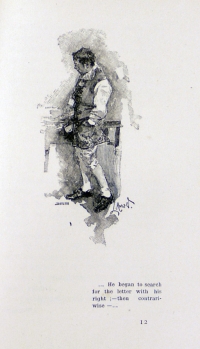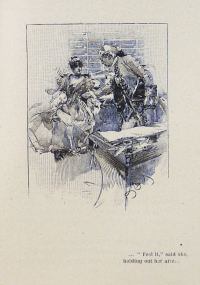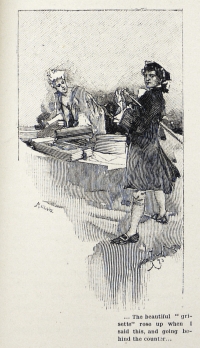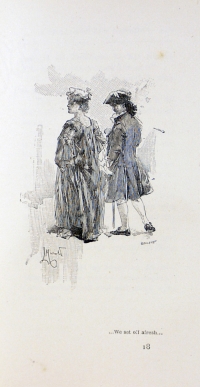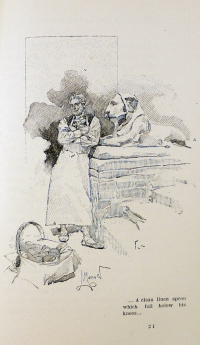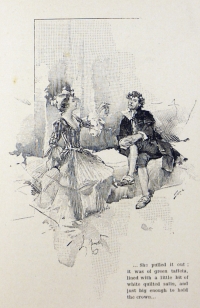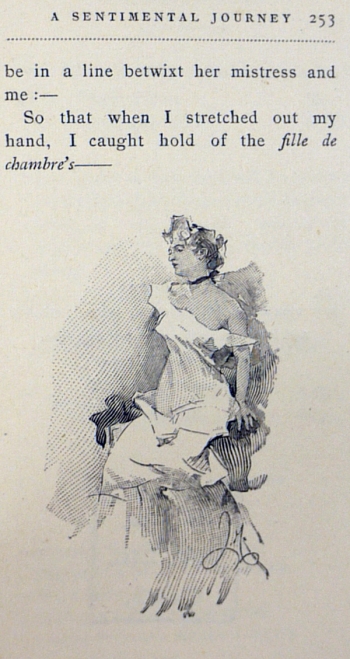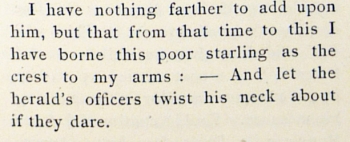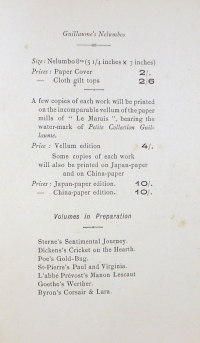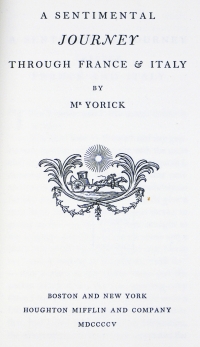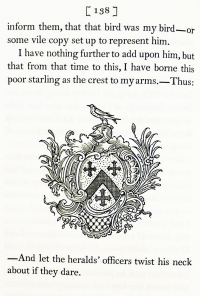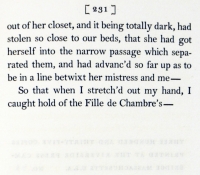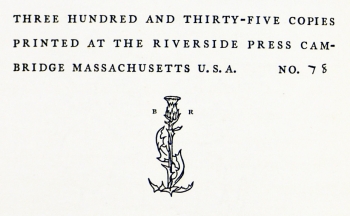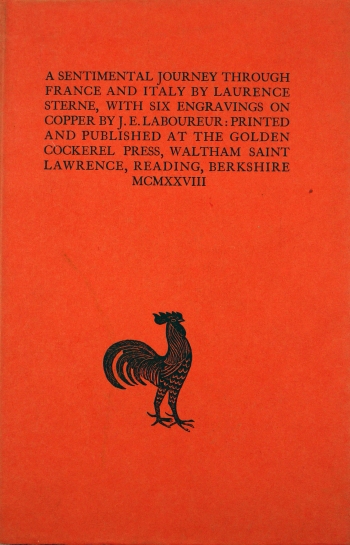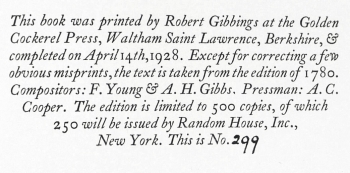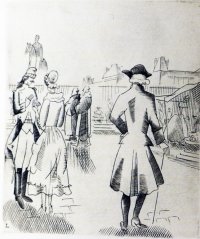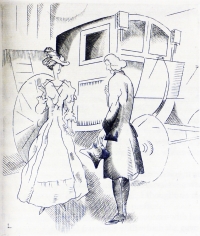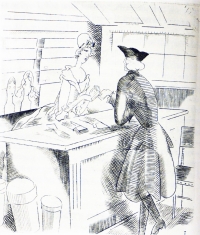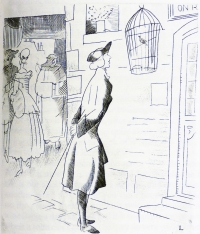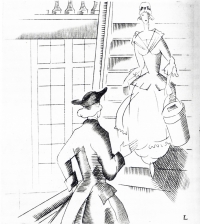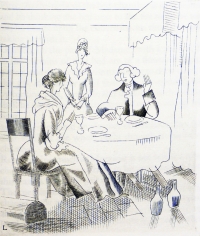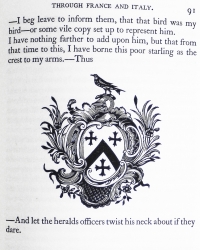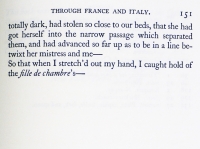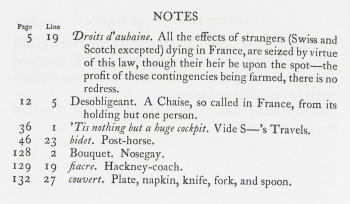I like a good distinction in my heart
Among the books in the Upper Library is a volume of fragments (Aa.5.1) from the collection of Johnian classicist Churchill Babington (1821-1889); one of those fragments, part 38 of the volume, is a facsimile page of the manuscript of Laurence Sterne’s A Sentimental Journey through France and Italy (1768), accompanied by a typeset version.
Sterne (1713-1768) was an Irish writer, an Anglican clergyman and a graduate of Jesus College, best known for his experimental 1759-1767 novel The Life and Opinions of Tristram Shandy, Gentleman (the subject of an earlier Spotlight). A Sentimental Journey accounts for the travels in Europe of Sterne’s alter ego, the Reverend Mr Yorick (a character who dies in Tristram Shandy): it is based upon Sterne’s experiences, and as the title suggests it is an exercise in sentimentalism, describing experiences not with documentary detachment but from an emotional perspective.
Several editions of A Sentimental Journey, spanning 160 years, are held in the St John's special collections: while many of the differences between them are to be found in the expected areas of pagination, typefaces and the like (none of these necessarily unimportant), there are also edition-to-edition variations that have a more obvious impact upon the reader’s perception of the novel's behaviour, and this Spotlight considers some of those.
A/G.15.22 (1768)
Sterne wrote two of an intended four volumes of A Sentimental Journey. The separate title pages and pagination of the two volumes contained in this binding indicate that in this first edition they were printed separately, and bound thus at a later point. The first volume contains a list of subscribers, the beginning of which is pictured here; the asterisked names were subscribers to the larger ‘imperial paper’ version.
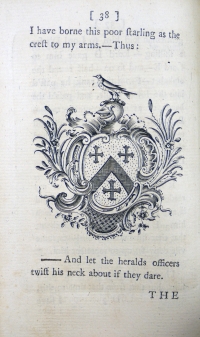
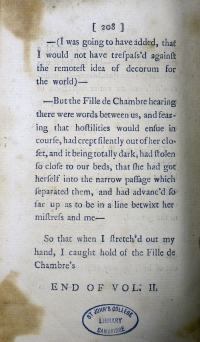
15.55.130 (1769)
Here the book does consist of four volumes, the latter two written by John Hall-Stevenson, Sterne’s friend, under the name ‘Eugenius’ (to whom Sterne’s original is addressed). Unlike in the previous item, the four volumes are continuously paginated, with the foreword to the third switching to Roman numerals for its page numbers. Hall-Stevenson picks up a moment before Sterne’s second volume ends, insisting, unpersuasively and unpersuaded, that Yorick has caught hold merely of the fille de chambre’s hand; by concluding Sterne’s portion of the book with ‘The End of the Second Volume’, one ruder interpretation is muted, although Hall-Stevenson’s portion does delight in protesting too much.
Now I think, that if we consider the occasion – notwithstanding the fille de chambre was as lively a French girl as ever moved, and scarce twenty – if we consider that she would naturally have turned her front towards her mistress by way of covering the break occasioned by the removal of the corking pins [from the bedcurtains] – it would puzzle all the geometricians that ever existed, to point out the section my arm must have formed to have caught hold of the fille de chambre’s –
But we will allow them the position – Was it criminal in me? was I apprised of her being so situated? could I imagine she would come without covering? for what, alas! is a shift only upon such an occasion?
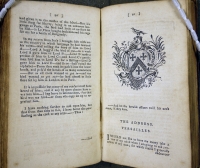 The relative sizes of page and text have notably made the insertion of the coat of arms less tidy than it might have been, leaving an awkward space on p. 90 and indeed, if one is inclined to read catchwords, causing the image to interrupt the transition from the promise of ‘And’ at the end of the verso page and its arrival on the following recto.
The relative sizes of page and text have notably made the insertion of the coat of arms less tidy than it might have been, leaving an awkward space on p. 90 and indeed, if one is inclined to read catchwords, causing the image to interrupt the transition from the promise of ‘And’ at the end of the verso page and its arrival on the following recto.
20.10.40 (1780)
This edition is the fifth part of a multi-volume set of Sterne’s complete works (Tristram Shandy having taken up the first four); as well as including the coat of arms, it is the earliest of the Library’s editions to include further illustration, in this case a frontispiece image depicting Yorick, in the company of a lady as he often is, exchanging snuffboxes with a monk he previously treated uncharitably.
The conclusion restores ‘End’ sans article.
H.14.27 (1782)
‘The End’ returns in this edition, which again features a frontispiece illustration, this time referring to an episode wherein Yorick, touched by the kindness of a shopkeeper’s wife who has given him directions, contrives to feel, at length, her pulse (speculating that as she has such a good heart she ‘must have one of the best pulses of any woman in the world’). He manages not to offend her husband by doing so.
Ga.19a.21 (1792)
While there is no frontispiece, several illustrations feature in this printing: they include the aforementioned snuffbox exchange, a man mourning his dead ass (as described in the facsimile manuscript above), the feeling of the pulse (before the husband arrives), the encouter with the caged starling, a conversation with Maria (who also appears in Tristram Shandy) and Yorick attending a dance.
Another ‘The End’ edition, this has left a space for the coat of arms without including the image. Those familiar with Tristram Shandy but reading A Sentimental Journey for the first time in this edition could be forgiven for taking this omission as an authorial jest.
4.40.54 (1894)
A leap of just over a century introduces this prettily bound, late Victorian edition of the novel, whose illustrations include: the Calais hotel master Monsieur Dessein; Yorick's servant La Fleur; the pulse-feeling incident; Yorick trying on gloves; Yorick walking with a girl he meets at a bookshop; a pâté-seller; and Yorick inspecting a (not the) fille de chambre's purse.
The numbers to the bottom right of some of the illustrations refer not to the image, or their captions, but to the fact that these pages mark the beginning of a new quire, or gathering, of eight pages.
The coat of arms is deliberately absent in this printing, and so that it is not missed by first-time or forgetful readers the word ‘thus’ following the description has been removed. And no text follows the ending's cut-off sentence: instead a picture, presumably of the fille de chambre, speaks a thousand words, or perhaps only one (and mirrors the picture of Yorick and another lady that appears just before the book's opening line: '"They order," said I, "this matter better in France."')
At the end of the book is a list of the prices of the various bindings of this edition, some more luxurious than others, along with an indication of other texts included in the series. The Library's copy is one of the 'cloth gilt tops' bindings; unlike the other books discussed in this Spotlight, it is not a special collections item, and is borrowable from the open-access Garden Basement in the Working Library.
Maxwell R.46 (1905)
This volume, number 78 of a 335-copy edition, is without additional illustrations, and has no text following its terminal dash.
BS G3.12.2 (1928)
The Brice-Smith Collection in the Lower Library is the home of the Spotlight’s final item, number 299 of a delightfully illustrated 500-copy edition of the novel. The orange-red dustjacket replicates the title page, and notes that the six new illustrations are engravings by J.E. (Jean Émile) Laboureur.
They depict Yorick’s arrival in Calais; his meeting with the lady who will shortly witness the snuffbox exchange; the pulse-checking incident; the caged starling; a meeting with a society lady, perhaps the Madame de V*** whom Yorick persuades away from deism; and the discussion with the final sequence’s lady and her fille de chambre about sleeping arrangements, which again come to an embarrassing end with a dash and a blank space.
Also of note regarding this edition is that it gathers Sterne’s footnotes into a set of endnotes that are not pointed to in the main text: this has the effect of making the notes seem more editorial than authorial, arguably detracting from their contribution to the comedy.
*
Whether further editions of A Sentimental Journey make their way into the Old Library remains to be seen; with Sterne not being a Johnian, actively acquiring them is unlikely ever to be a priority. Still, the nine items featured here give an indication of how one text can find itself in various incarnations in a single library even without there being any sentimental link (as it were) between the library and the author; it is not impossible that another version of Yorick's travels could one day join them.
This Special Collections Spotlight article was contributed on 10 July 2017 by Adam Crothers, Special Collections Assistant, who despite having now written three of his Spotlights on bawdy subjects has never even caught hold of a fille de chambre's
